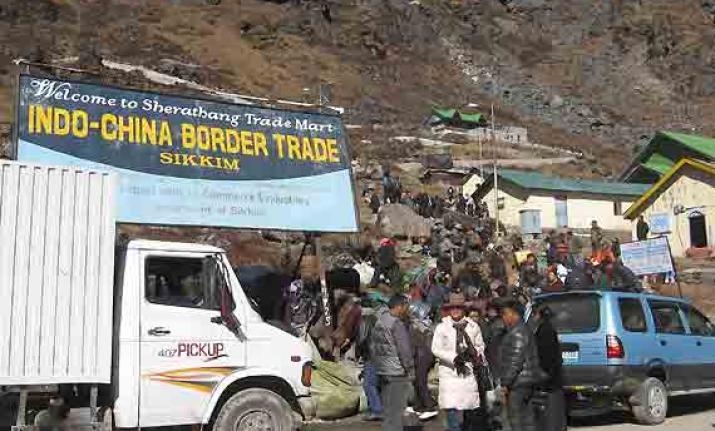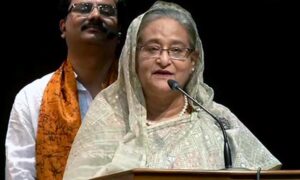
File Picture Courtesy : India TV ( representational image only)
Geography , religious demographics and identity politics largely shaped the nation and state building efforts of the Indian subcontinent in the 19th and 20th century which have not really ended in Pakistan , Myanmar and even Nepal, Bhutan and Bangladesh ; and notwithstanding the Chinese position Tibet is awaiting fulfilment of a distinct political identity.
The political maps drawn up following withdrawal of the British power left south Asia not only fractured but laid down land borders which are difficult to demarcate due to the sheer length, difficult terrain and overlapping population and even went against nature as the Delta like Bengal doesn’t lend itself to a political division.
In fact no large Delta any where in the world have been ” partitioned” except Bengal. Indeed, the 1947- 48 political reorganisation disrupted and destroyed the vibrant sub Regional economy that encompassed India’s East and North East ,Myanmar, Tibet and even Thailand and Malay Peninsula.
From this perspective, it is clear that our border trade policy and strategy have the object of reviving the old trade links on modern basis and to undo the damage caused. However, it could not even be considered along our 2900km of land borders with Pakistan as the border has been fenced and 150000 Flood lights installed on 50000 poles on the Indian side are so pronounced that it is visible from the space and viewed by former US President Bill Clinton as ” one of the most dangerous borders”. Obviously there could be no border trade given the fact that the share of India’s Pakistan trade is les than 1% of the total foreign trade.
The internationally recognised definition of border trade is that it refers to ” flow of goods and services across International borders between jurisdictions . In this sense it is a part of normal legal trade that flows through export/ import framework of nations. “Border Trade is different from trade through air, land and sea routes as trade through ports involve customs clearance and has large volume.
Border trade is ” Overland” trade by way of” exchange of commodities “from a bilaterally agreed list by People living in both sides of the international border; and it is mainly trade in locally produced commodities as per prevailing customary practices. It is thus clear that the object of border trade is to minimise disruption of normal economy of the people of border region and founded on friendship and cooperation which often require deft handling as security and matters like illegal migration, smuggling especially of illicit drugs create challenge to ground level cooperation for both the countries and more so when the border fencing is carried out by a country to deal with these problems.
The ongoing joint fencing project along 1643 km length of India Myanmar border in Arunachal Pradesh, Nagaland, Manipur and Mizoram sectors indicates the common security concerns of India and Myanmar. However, fencing along 4156 km long India- Bangladesh land border, the fifth longest Land border in the world of which roughly 1741km pass through the North East region is entirely a decision of India in her security interest.
The construction of fencing gained momentum in 2007 and as of now 2649 km of fencing along 3326 km of border roads have been completed- a commendable effort by any standard given the terrain and the task of construction of border roads and the security infrastructure in high rainfall and flood prone lands.
The state wise break up of India- Bangladesh border in the North East region is interesting as 856 km and 443km are in Tripura and Meghalaya respectively while 180 km and 263 km are in Mizoram and Assam sectors of the border. Of 263km in Assam sector, 143.9okm is riverine of which 222 km of fencing had been completed and flood lights installed. These facts and security aspects need appreciation because border trade in South Asia is more a political and strategic move than a commercial activity.
This becomes clear when we look at the 4057km long Sino Indian border along States of J and K, Uttarakhand, Himachal, Sikkim and Arunachal to note that there’s little border trade except through Nathu la pass in Sikkim and potential of other Trading points have remained unutilized mainly due to lack of enthusiasm on the part of the Chinese as the latter would prefer to go slow in expanding border trade.
In the backdrop of the Act East policy and the Prime Minister Modi’s vision of making the North East India the engine of India’s growth, if we give a hard look at the border trade with Myanmar, the entry point to ASEAN,one is struck by the fact that the size of the border trade carried out through Land customs stations at Moreh in Manipur and Zawkhathar in Mizoram and Tamu and Rhi on the Myanmarese side remained hovering around USD 1-2 million at the most till date after signing of the India Myanmar trade agreement in 1994 and operationalized on 12.4.1995. The Agreement provided for a concessional 5%duty on 40 approved items while other high value items were allowed to be traded normally on payment of customs duty.
The value of the illegal trade is believed to be at least 5 times more than the legal trade covering products from China, Thailand, Korea and Japan . To restore the balance appropriate trade and investment policies are needed to remove the supply side constraints faced by the North East States by setting up special economic and Technology zones on the Yunnan model close to the Myanmar border for manufacturing products which are in high demand in upper Myanmar and regions adjacent to the North East such as cement, machinery and engineering goods, dairy products, car and bicycle parts, plastics and pharmaceuticals as these items could be manufactured or assembled close to the Myanmar Border.
This seems to be the only way to move away from the present ” barter system” which by its very nature is confined to local agro based products and cannot get the border region to a high growth path and might facilitate setting up of more Land customs stations.
In contrast the border trade with Bangladesh and the North East region has seen robust growth mainly due to huge increase in export of coal, limestone, sand and stones, cement from Meghalaya and value added products from Tripura like vulcanised rubber, bicycle parts, citrus fruits and plywood and wood products.The North East Bangladesh bordertrade has been around USD 1 billion annually and have a huge potential once the Kaladan multimodal transport project is made operational.Only then the North East could reap the benefits of South Asia Free Trade Zone- SAFTA.
The border trade at Nathu La with Tibet which began following india China trade agreement in July 2006 seems to have progressed well and the trade balance has been in favour of India because while 15 duty free import items from China are primary products like sheep and goat skin, yak tail, goat Cashmere which are processed for value addition in India, high demand in Tibet for the Indian manufactured products like bicycles, kerosene Oil, watches, agrochemicals which are within the list of 29 duty free exportable items have enabled India to score an edge in trade balance.
Contrary to the popular perception, the Tibet trade has high potential because parts of Tibet close to Uttarakhand and Himachal had till 1950 robust trade through Trading outposts like Lipi Lekh and Ship kela in Uttarakhand which could be revived to the advantage of both the countries.
In the same way the potential of Je lep la in Kalimpong sector as a major Trade point for Tibet could be tapped as a part of the broad strategy for integrating border trade in the larger Trade between India and China. And, such a synergy — as global experience shows stabilizes borders by creating constituencies for peace and progress. Quite possibly our Act East initiative underscores the need for such a coherent synergy. It is therefore time now to look at Border Trade as a major plank of North East Regional development strategy.
( The writer is a retired IAS officer of the Assam – Meghalaya cadre and has served as Scientific Consultant in the office of the Principal Scientific Advisor to the Government of India)


















